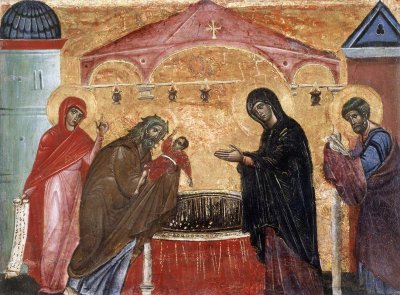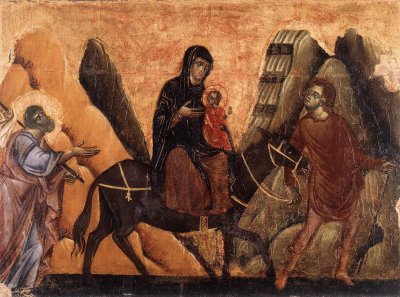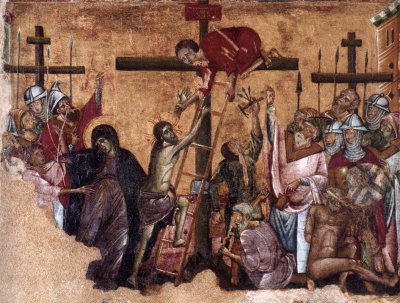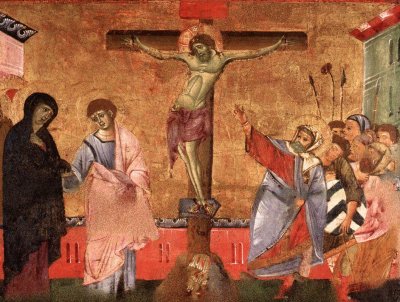| |
Guido di Siena:
Badia Ardenga Altarpiece
|
The panels shown here were
taken from a dismantled altarpiece, or dossal, from the abbey of
Ardenga in Montalcino, Tuscany. They ended up in galleries around the
world, and the original configuration is unclear. The attempt to
reconstruct it by Holger Manzke is shown below; this is extremely
hypothetical and a number of art historians do not go along with it.
One suggestion is that they formed an altar frontal, with no central
image.
Little is known of the Artist Guido di Siena, who worked c 1260 - 1280 in
Siena. |
| |
 |

Coronation of the Virgin.
Courtauld Gallery, London
|
| It is by no means certain
that this formed the crowning panel of the Bardia Ardenga altarpiece,
but it is an interesting image, thought to be the earliest depiction of
the Coronation of the Virgin in Sienese art. Enlarged image of the
central image below. The Latin text held by Christ says 'Come my chosen one and let me place you on my throne'. |

|
| |

Annunciation. University Art Museum, Princeton
|

Nativity. Musée du Louvre, Paris. |
The top left hand corner of the
Annunciation does suggest that the reconstruction shown above is
correct, though this may be a later alteration. The Nativity is
typically Byzantine: The Virgin lies in a cave, with the Christ child
behind her. Another image of the Christ Child is before her, being
washed by two maidens. Joseph is to the left: the shepherds arrive on
the right, welcomed by the angel in red. Presumably the dog belongs to
the shepherds and has got there first.
|

Adoration of the Magi. Lindenau-Museum, Altenburg. |

Presentation of Jesus at the Temple. Musée du Louvre, Paris.
|
| The
Magi have arrived, and their horses are to the left. Curious mountains,
trees and buildings are behind. The Virgin sits sideways on a
forward-facing throne. In the Presentation scene, Joseph stands on the
right, holding his offering of two turtle doves. On the left is
the Prophetess Anna, mentioned in the Gospel of Luke. |

Flight into Egypt. Lindenau-Museum, Altenburg.
|

Massacre of the Innocents. Pinacoteca Nazionale, Siena. |
| An
attendant leads the horse in the Flight into Egypt, while Joseph, with a
bundle over his shoulder, follows on. Some legends suggest that the
attendant is a son of Joseph from a previous marriage. The Massacre of
the Innocents is very badly damaged. Herod gives orders to his troops
from the window, while on the left we see powerful images of the
grief-stricken mothers. An enlarged image is reproduced below. |
 |

Kiss of Judas. Pinacoteca Nazionale, Siena.
|

Flagellation. Lindenau-Museum, Altenburg. |
| The
left-hand side of the Kiss of Judas scene is missing. The figure on the
right, probably St Peter, tries to prevent the incident happening. In
the Flagellation scene, the figures right and left are damaged, and it
is suggested that devotees deliberately scratched them. |

Ascent to the Cross. Museum Catherijneconvent, Utrecht.
|

Crucifixion. Pinacoteca Nazionale, Siena. |
| The
Ascent to the Cross is an unusual scene in religious art. Here, a figure
in red pulls Christ upwards, while Mary tries to hold him back, and push
away the soldiers. Beneath the cross a figure holds up a hammer and
three nails. On the right, one of the thieves is shown as a naked
figure. The Crucifixion scene shows Mary and St. John on the left, but
who is the haloed figure on the right? Joseph of Arimathea, perhaps.
|

Deposition. Pinacoteca Nazionale, Siena.
|

Lamentation. Pinacoteca Nazionale, Siena.
|
| The
deposition scene has been quite heavily restored. Mary holds the body of
Christ, while a bearded figure, possibly Joseph of Arimathea supports
it. Joseph appears in this role in other early paintings. The other,
younger bearded figure may be Nicodemus. At the bottom a figure is
removing the nails from the feet of Christ, whose body is very
distorted. The figure on the right may be Mary Magdalene. The
Lamentation scene is also badly damaged. The weeping figures on the left
bring back the memory of the weeping mothers in the Massacre of the
Innocents.
|
 |
The two Madonna and Child paintings below have both be considered as
forming part of the altarpiece. In both cases, this is unlikely, but it
does provide an excuse for looking at two interesting examples of
Sienese art. The Madonna is the patron saint of Siena, and it has been
claimed that she ensured the city's success in warfare, especially
against Florence. |
 |
 |
The painting on the left above is in
the Cathedral of Siena, and is known as the Madonna delle Grazie. In the
fourteenth century it was highly regarded, and was even claimed to work
miracles. As you can see from the attempted reconstruction at the top of
the page, Holger Manzke suggested that it was at the heart of the
altarpiece we are looking at; there is a further suggestion that this
altarpiece was originally placed in the cathedral and was moved to
a new location later, perhaps when Duccio outdid it with his Maesta c
1310. More recent research suggests a different attribution, Dietisalvi
di Speme, an artist active around the same time as Guido de Siena.
The Madonna above right was in the church of San Domenico; it is
now in the Palazzo Publico. A partial signature seems to identify Guido
as the artist, though there is confusion over the inscription, which
contains a date of 1221, long before Guido and in no way approriate to
the style here. It has been linked with the Badia Ardenga polyptych, but
its large size make this improbable.
|
Home page:
explore the site |


















